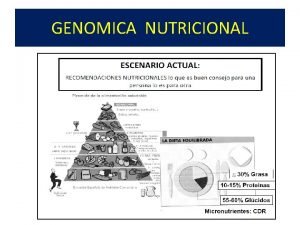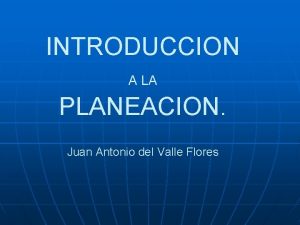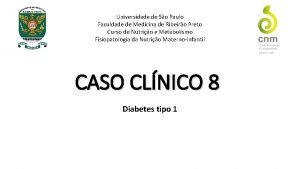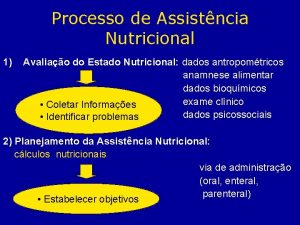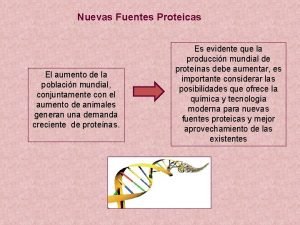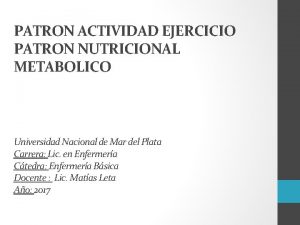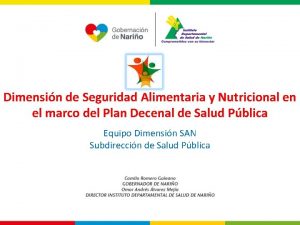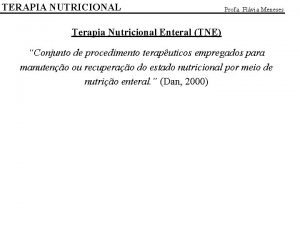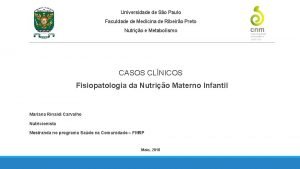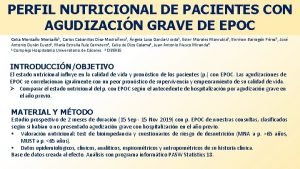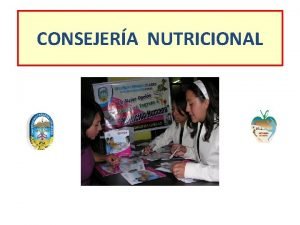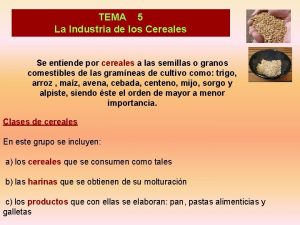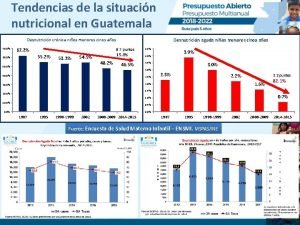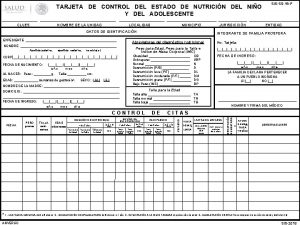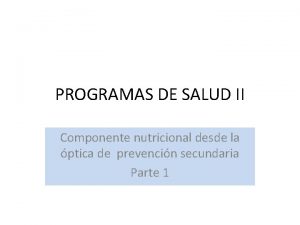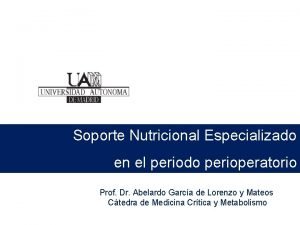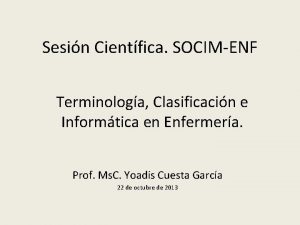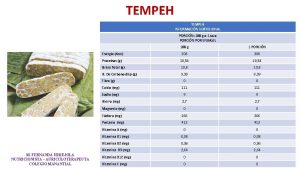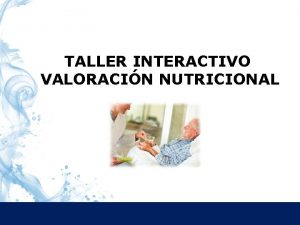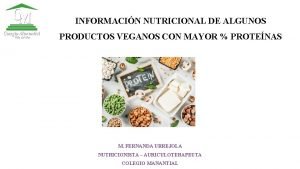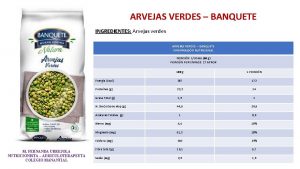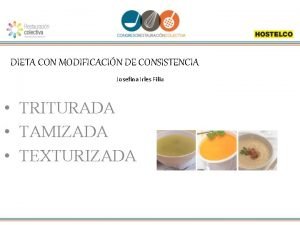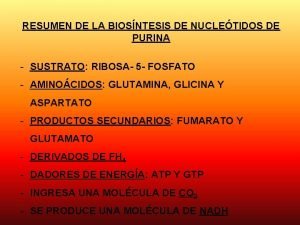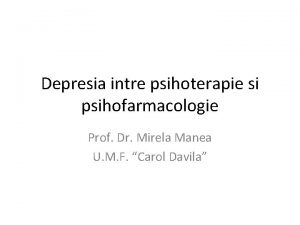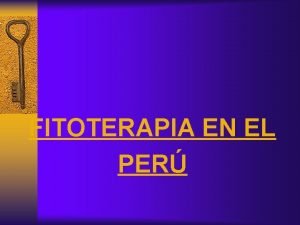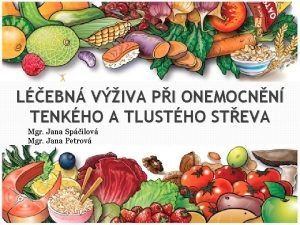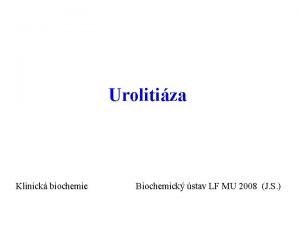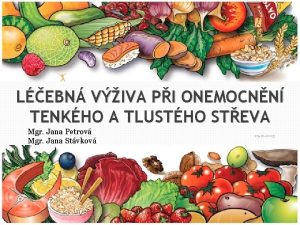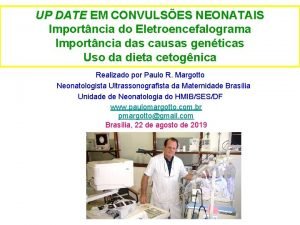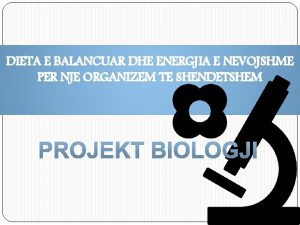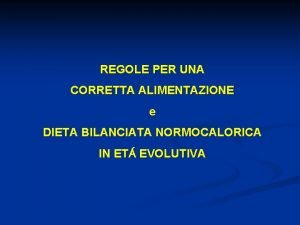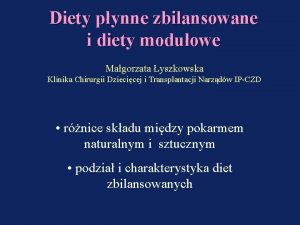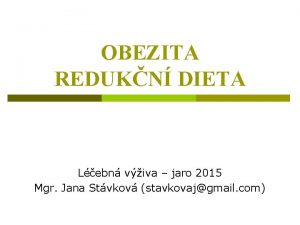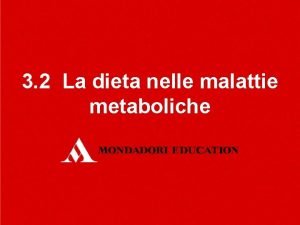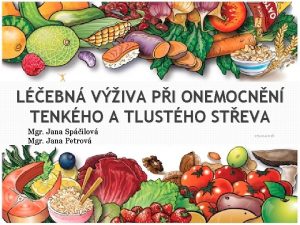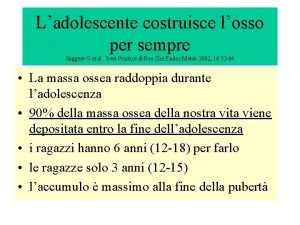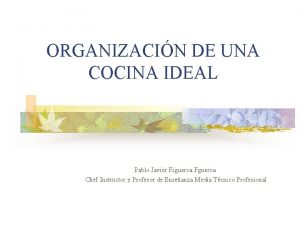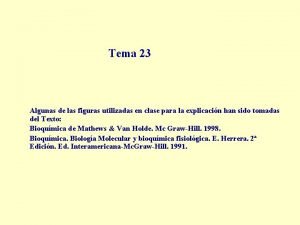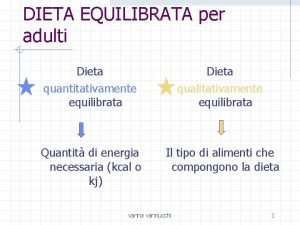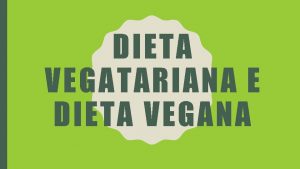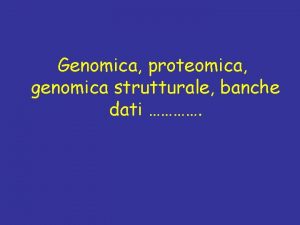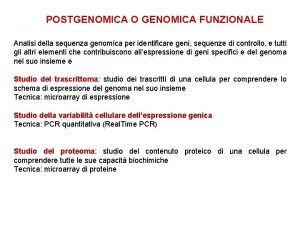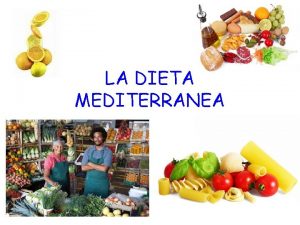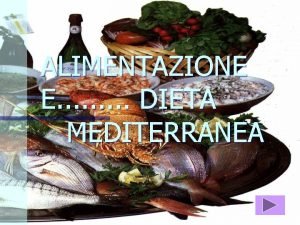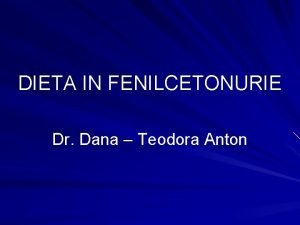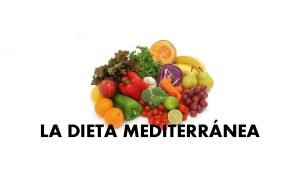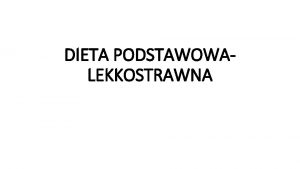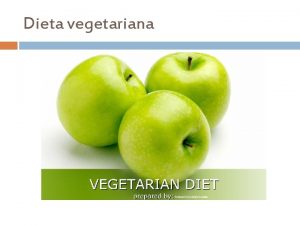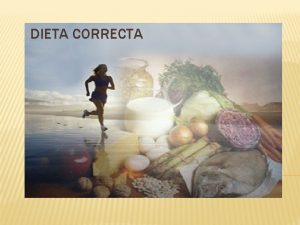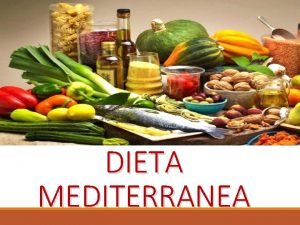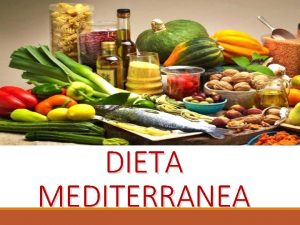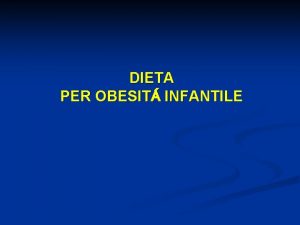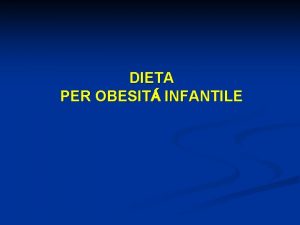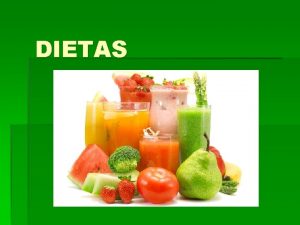GENOMICA NUTRICIONAL Dieta personalizada GENOMICA NUTRICIONAL La informacin
































































- Slides: 64

GENOMICA NUTRICIONAL

Dieta personalizada? ? ?

GENOMICA NUTRICIONAL • La información para los procesos fisiológicos involucrados en la nutrición se encuentra en el genoma, y determina qué nutrientes y en qué cantidades son necesarios para las respuestas homeostáticas, teniendo como determinante de su expresión final la interacción con la dieta. • La genómica nutricional establece como principal objetivo aportar el conocimiento que permita hacer un diagnóstico y establecer un tratamiento nutricional basado en el genotipo individual, mediante 2 ramas principales: LA NUTRIGENÉTICA Y LA NUTRIGENÓMICA

Conceptos

GENOMICA NUTRICIONAL


Alimento nutrigenomico



Restricción calórica & longevidad





GENOMICA NUTRICIONAL Concepto • • • Nutritional genomics is a science studying the relationship between human genome, nutrition and health. It can be divided into two disciplines: Nutrigenomics: studies the effect of nutrients on health through altering genome, proteome, metabolome and the resulting changes in physiology. Nutrigenetics: studies the effect of genetic variations on the interaction between diet and health with implications to susceptible subgroups. [1] More specifically, nutrigenomics studies how individual differences in genes influence the body's response to diet and nutrition. For example, people with an enzyme deficiency caused by mutations in the enzyme phenylalanine hydroxylase cannot metabolize foods containing the amino acid phenylalanine and must modify their diets to minimize consumption. With modern genomic data, severe gene mutations with less severe effects are being explored to determine whether dietary practices can be more closely personalized to individual genetic profiles. However, there have been few validated studies for these kinds of classical gene mutation effects. [2]

1. NUTRIGENETICA Concepto • Nutrigenetics is the retrospective analysis of genetic variations among individuals with respect to the interaction between diet and disease. It is an applied science that studies how the genetic makeup of an individual affects the response to diet and the susceptibility to diet-related diseases. This necessitates the identification of gene variants associated with differential responses to nutrients and with higher susceptibility to diet-related diseases. The ultimate goal of nutrigenetics is to provide nutritional recommendations for individuals in what is known as personalized orindividualized nutrition. A number of companies have begun offering nutrigenetic testing, but the recommendations are often highly generic, and could provide a false sense of security. As these companies are not offering specific clinical advice, they do not qualify for regulation beyond the accuracy of the genetic test applied. Objections to such testing kits in the UK have led to the voluntary suspension of commercial testing activity there, and in the US severe criticisms have been leveled against various testing

• La nutrigenética es una ciencia aplicada marcada por los paradigmas de la farmacología nutricional en relación con los polimorfismos y la experiencia clínica. Así como la farmacogenética busca mejorar el diseño de fármacos, según la influencia de las variaciones genéticas en el metabolismo de los xenobióticos y en las dianas de fármacos en el paciente, la nutrigenética ofrece la posibilidad de personalizar la nutrición de acuerdo con la constitución genética de los consumidores, teniendo en cuenta el conocimiento de las variantes genéticas que afectan al metabolismo de los nutrientes y a las dianas de éstos. En definitiva, la nutrigenética hace referencia al análisis de variaciones genéticas entre individuos y su respuesta clínica a nutrientes específicos. • Un ejemplo serían los individuos con diferentes valores de colesterol sérico y presión arterial por variaciones genéticas, aun con dieta estándar








2. NUTRIGENOMICA Concepto • • • Not to be confused with Nutrigenetics. Nutrigenomics is the study of the effects of foods and food constituents on gene expression. [1] This means that nutrigenomics is research focusing on identifying and understanding molecular-level interaction between nutrients and other dietary bioactives with the genome. Nutrigenomics has also been described by the influence of genetic variation on nutrition by correlating gene expression or single-nucleotide polymorphisms with a nutrient's absorption, metabolism, elimination or biological effects. By doing so, nutrigenomics aims to develop rational means to optimisenutrition, with respect to the subject's genotype. By determining the mechanism of the effects of nutrients or the effects of a nutritional regime, nutrigenomics tries to define the causality|relationship between these specific nutrients and specific nutrient regimes (diets) on human health. Nutrigenomics has been associated with the idea of personalized nutrition based on genotype. While there is hope that nutrigenomics will ultimately enable such personalised dietary advice, it is a science still in its infancy and its contribution to public health over the next decade is thought to be major. [2]

• La nutrigenómica es una rama de la genómica que pretende proporcionar un conocimiento molecular (genético) en los componentes de la dieta que contribuyen a la salud mediante la alteración de la expresión y/o estructuras, según la constitución genética individual. • Así, por ejemplo, la nutrigenómica estudia el papel de los ácidos grasos poliinsaturados en la expresión genética de su oxidación y utilización de energía

NUTRIGENOMICA Consulta • • • Understanding the nutrigenomic definitions and concepts at the food-genome junction. Subbiah MT. Department of Internal Medicine, University of Cincinnati Medical Center Cincinnati, Ohio 45267, USA. Ravi. Subbiah@uc. edu Abstract The marked differences in individual response to dietary factors have led to major controversies in nutrition and puzzled nutrition scientists over the last century. The emerging field of nutrigenomics helps us to understand the basis for some of these differences and also promises us the ability to tailor diet based on individual genetic makeup. Great advances in Human Genome Project, documentation of single nucleotide polymorphisms (SNPs) in candidate genes and their association with metabolic imbalances have gradually added new tests to the nutrigenomic panel. Studies based on ethnopharmacology and phytotherapy concepts showed that nutrients and botanicals can interact with the genome causing marked changes in gene expression. This has led to the commercial development of nutraceuticals and functional foods that can modify negative health effects of individual genetic profile bringing the field to the "food/genome" junction. Despite the promise of nutrigenomics to personalize diet, there is skepticism whether it can truly bring about meaningful modification of the risk factors connected to chronic diseases, due to the lack of large scale nutrition intervention studies. Several intervention studies currently underway in the United States and abroad (Israel, Spain, and France) will further help validate nutrigenomic concepts. France has already introduced a National Nutrition and Health Program to assess nutritional status and risk of major metabolic diseases. As the field(s) related to nutritional genomics advance in their scope, it is essential that: (a) strict guidelines be followed in the nomenclature and definition of the subdisciplines; and (b) the state/federal regulatory guidelines















Genoma & Epigenoma • The genome is defined as the total content of genetic information possessed by an organism. The epigenome is consisted of the modifications of DNA and histone structure influencing gene expression. The epigenomic modifications include DNA methylation, posttranslational histone modification, and chromatin remodeling (Rajender et al. , 2011). • Extensive researches have demonstrated relationships between gene expression and epigenomic modifications. For example, hypermethylation of DNA is associated with suppression of gene expression, while hypomethylation of DNA is correlated with genetic expression (Biermann and Steger, 2007). In addition, histone acetylation is closely related with an increase of gene transcription (Berger, 2002).

• Thus, these findings suggest that any types of epigenomic modifications could influence on gene expression, activation or suppression of gene expression. Of these epigenomic modifications, the degree of methylation of DNA and histone is precisely controlled by actions of methyltransferases (Biermann and Steger, 2007). Therefore, it is possible that changes of degree of epigenomic modifications during the development could induce the differential expression of specific gene within a tissue.

EPIGENETICA Concepto • La epigenética es el estudio de modificaciones en la expresión de genes que no obedecen a una alteración de la secuencia del ADN y que son heredables. • Una de las fuentes de mayores modificaciones de los genes es el factor ambiental y puede afectar a uno o varios genes con múltiples funciones. Por medio de la regulación epigenética se puede observar cómo es la adaptación al medio ambiente dada por la plasticidad del genoma, la cual tiene como resultado la formación de distintos fenotipos según el medio ambiente al que sea expuesto el organismo. • Estas modificaciones presentan un alto grado de estabilidad y, al ser heredables, se puedan mantener en un linaje celular por muchas generaciones. • Esto es importante ya que cuando hay errores en las modificaciones se pueden generar enfermedades que perduren en una familia por mucho tiempo.

EPIGENÉTICA Mecanismos silenciadores Comprende: Metilación de DNA Modificación de histonas: Deacetilación Metilación RNA de interferencia

Metilación • Recent research suggests that nutritional imbalances occurring at critical stages of life may have a long-lasting influence on the expression of various genes, including some of those thought to be influencing the Western obesity epidemic. This forms part of a branch of science called epigenetics which is concerned with how our environment can change the way our genes are expressed, independent of our DNA sequence. • During the course of life there are many types of modification that keep genes repressed or active, but the best studied is DNA methylation. During this process, a group of four atoms called a methyl group attaches to a gene at a specific point and alters its function. The methyl group silences the gene or reduces its expression inside a given cell, but does not actually change the gene. Such an effect is referred to as 'epigenetic' because it occurs over and above the gene sequence without altering any of the letters of the four-unit genetic code. What is interesting is that DNA methylation patterns are responsive to environmental factors such as nutrition throughout life.

• Many micronutrients and vitamins are critical for DNA synthesis/repair and maintenance of DNA methylation patterns. Folate has been most extensively investigated in this regard because of its unique function as methyl donor for nucleotide synthesis and DNA methylation. Folate therapy is a common method to reduce hyperhomocysteinaemia, restore DNA methylation to normal levels and correct the patterns of gene expression 19. The methyl groups are ultimately derived from methionine. High dietary methionine intake might therefore be expected to correct DNA methylation. However, Waterland claims that excessive methionine intake, such as through supplementation, may actually impair DNA methylation by inhibiting remethylation of homocysteine. This, he argues, could lead to hypermethylation of certain sections of DNA, which could have deleterious consequences 20. It is feasible to suggest that both an underweight malnourished an overfed but undernourished mother could be lacking in the adequate balance of methylating nutrients. Hence using diet and supplements preventatively to balance methylation processes can in some cases help to correct genetically based epigenetic deficiencies.

Nutrientes & Metilación

Desnutrición: hipometilación • More recently researchers have started to follow up on these observations and causal links are starting to emerge. In one study, feeding pregnant rats a protein restricted diet was found to induce hypomethylation of the glucocorticoid receptor (GR) and peroxisome proliferator activated receptor alpha (PPARα) promoters in their offspring 8. GR and PPARα are transcription factors that play key roles in corticosteroid action and in glucose and fat metabolism. Over expression of these factors due to hypomethylation induces dyslipidaemia, obesity, hypertension, hyperinsulinaemia and hyperleptinaemia in the offspring.

• What the researchers discovered was that feeding a protein restricted diet during pregnancy resulted in a reduction in the activity of methylation maintaining enzymes called DNA methyltransferases. This supports the hypothesis that hypomethylation may result from a failure to maintain DNA methylation patterns during development. Interestingly, supplementation of the protein restricted diet with folic acid, a methyl donor cofactor, prevented changes to the methylation status of the GR and PPARα promoters and led to the normalisation of GR, PPARα and DNA methyltransferase activity. This dovetails nicely with currently nutritional understanding of the importance of folic acid and the amino acid methionine in balancing methylation processes.


Leche materna • A recent study of over 15, 000 children, conducted by Mayer. Davis and colleagues, found that breastfeeding was protective against childhood obesity regardless of maternal BMI. Potential pathways that may be involved include a relatively reduced early postnatal weight gain, a better learned selfregulation of food intake, enhanced satiety or potentially the occurrence of factors present in breast milk but not in infant formula such as the satiety hormone leptin. Under normal conditions, leptin acts centrally, primarily at the hypothalamus, to inhibit feeding and promote energy expenditure. In addition, it reduces the deposition of fat and helps to maintain glucose sensitivity.

• Maternal diets high polyunsaturated fatty acids (PUFAs) had beneficial effects on the offspring's glucose control. • high carbohydrate: protein ratio in the maternal diet may also be linked to raised blood pressure 16 and impaired glucose homeostasis 17 in offspring.








pollos • The first report of this type of response was to temperature or thermal stress. The basis for these studies was to identify a mechanism to impart tolerance to acute heat stress in chickens produced in sub-tropical climates. • It was found that excessive thermal input during the first week of a chicken’s life modulated the response to thermal stress later in life (Yahav & Mc. Murtry, 2001). • By simply increasing the brooding temperature from 30°C to 37. 5°C for 24 hours within the first 5 d post-hatch birds are able to tolerate 6 hr of exposure to 35°C at 42 days of age, while “unconditioned” birds are unable to acclimate.

Adaptación a desnutrición: humanos • Adaptation to low nutrient diets has been long recognized. Animals respond to nutrient restriction by increasing absorption rates and utilization efficiency, which decreases excretion of the restricted nutrients. The ability of humans to adapt to a diet low in Ca was recognized in the 1950 s. At that time, the Food and Nutrition Board (1948) recommended an adult daily Ca allowance of 800 mg/d. • However, Hegsted et al. (1952) found that adult Peruvians, who had lived on low Ca diets for long periods, only required 100 to 200 mg Ca/d to maintain balance. It is obvious that these Peruvians, who grew up under Ca restriction, were able to better utilize Ca.

Adaptación a desnutrición: pollos • Adaptation to P and Ca restricted diets has also been previously reported in chickens. In an in-vitro trial, using ligated duodenal loops, Morrissey & Wasserman (1971) observed that broiler chicks absorbed a higher percent of a labeled 47 Ca (ranging from 70 to 90%) when diets low in Ca (0. 08%) were fed for eight d prior to intestinal sampling regardless of dietary P levels, or when low P (0. 25%) diets were fed regardless of dietary Ca levels. Chickens receiving a diet with normal P (0. 65%) and normal Ca (1. 20%) absorbed less than 50% of 47 Ca. Duodenal P absorption in 15 to 20 d-old chicks that had been fed a low Ca or a low P diet for eight d, as measured by ligated duodenal loop technique in vivo, increased by 49 and 87%, respectively (Fox et al. , 1981). • The adaptation to P or Ca restriction was believed to be a result of an increased level of circulating 1, 25 -(OH)2 -D 3 (Blahos et al. , 1987) and duodenal calbindin content

• effort to form the International Human Epigenome Project (IHEP) and characterize how the epigenome differs from tissue to tissue and how it responds to environmental changes (temperature, stress, disease, ect).
 Dieta hipocalorica
Dieta hipocalorica Informacin
Informacin Dr. juan antonio valle flores
Dr. juan antonio valle flores Fuentes de informacin
Fuentes de informacin Diagnóstico nutricional exemplo
Diagnóstico nutricional exemplo Níveis de assistência nutricional
Níveis de assistência nutricional Sampa valor nutricional
Sampa valor nutricional Patrones funcionales de marjory gordon
Patrones funcionales de marjory gordon Dimensión seguridad alimentaria y nutricional
Dimensión seguridad alimentaria y nutricional Ovotransferrina
Ovotransferrina Escala de glasgow
Escala de glasgow Nan a
Nan a Perfil nutricional laboratorio
Perfil nutricional laboratorio Momentos de la consejería nutricional
Momentos de la consejería nutricional Vgs tamizaje nutricional
Vgs tamizaje nutricional Industria de cereales
Industria de cereales Situacion nutricional en guatemala
Situacion nutricional en guatemala Ketopia menu
Ketopia menu Tarjeta de control de peso y talla
Tarjeta de control de peso y talla Anamnesis alimentaria
Anamnesis alimentaria Soporte nutricional perioperatorio
Soporte nutricional perioperatorio Guaba origen
Guaba origen Formato pes nutricion
Formato pes nutricion Tempeh informacion nutricional
Tempeh informacion nutricional Clasificación de la pirámide alimenticia
Clasificación de la pirámide alimenticia Vgs tamizaje nutricional
Vgs tamizaje nutricional Carne de soya mi tierra informacion nutricional
Carne de soya mi tierra informacion nutricional Cuscús carozzi información nutricional
Cuscús carozzi información nutricional Dieta texturizada disfagia
Dieta texturizada disfagia Dieta hipopurínica
Dieta hipopurínica Vita quieta mente lieta e moderata dieta
Vita quieta mente lieta e moderata dieta Dieta cronobiologica
Dieta cronobiologica Dieta sana
Dieta sana Dieta turmix hospitalaria
Dieta turmix hospitalaria Renaquilla
Renaquilla Bezezbytková dieta melta
Bezezbytková dieta melta Whewellit dieta
Whewellit dieta Carbohidratos de la dieta
Carbohidratos de la dieta Bkm dieta
Bkm dieta Bezezbytková dieta divertikulitida
Bezezbytková dieta divertikulitida Dieta cetogenica
Dieta cetogenica Ushqimet qe permbajne karbohidrate
Ushqimet qe permbajne karbohidrate Esempio di dieta bilanciata
Esempio di dieta bilanciata Dieta polimeryczna
Dieta polimeryczna Indicacoes
Indicacoes Pankreatitid
Pankreatitid Chudokrvnosť wikipedia
Chudokrvnosť wikipedia Dieta hiposodata
Dieta hiposodata Dieta wysokotłuszczowa
Dieta wysokotłuszczowa Dieta jogurtowa 3 dniowa
Dieta jogurtowa 3 dniowa Bezzbytková dieta
Bezzbytková dieta Dieta viva
Dieta viva Regla de mcdonald
Regla de mcdonald Perdite di sangue in menopausa
Perdite di sangue in menopausa Dieta kisielowa
Dieta kisielowa Un tríptico de un estilo de vida saludable
Un tríptico de un estilo de vida saludable Criterios de ranson
Criterios de ranson Bezezbytková dieta divertikulitida
Bezezbytková dieta divertikulitida En pruebas hechas en una dieta experimental para gallinas
En pruebas hechas en una dieta experimental para gallinas Dieta saggese
Dieta saggese Sfingolipidoza
Sfingolipidoza Que es dieta hipograsa
Que es dieta hipograsa Carbohidratos de la dieta
Carbohidratos de la dieta Dieta dos 21 dias pdf gratis
Dieta dos 21 dias pdf gratis Ushqimet e shendetshme projekt
Ushqimet e shendetshme projekt
